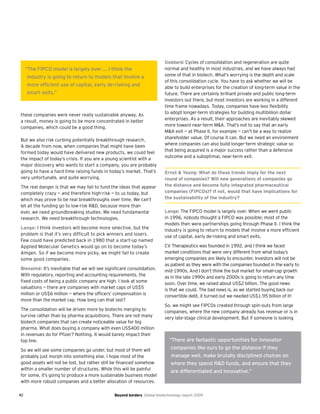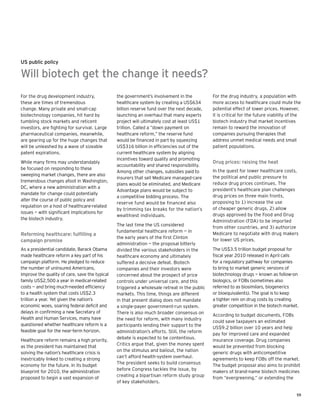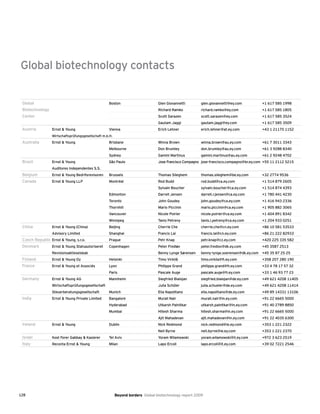The 2009 Beyond Borders Global Biotechnology Report outlines the severe impact of the global financial crisis on the biotechnology industry, creating a divide between successful and struggling firms. While the industry has faced funding challenges in the past, the current crisis is unique due to its systemic nature, stemming from failures in broader financial systems rather than just shifts in investor sentiment. It highlights the need for innovative strategies and collaborations within biotech to adapt and navigate these turbulent times for long-term sustainability.
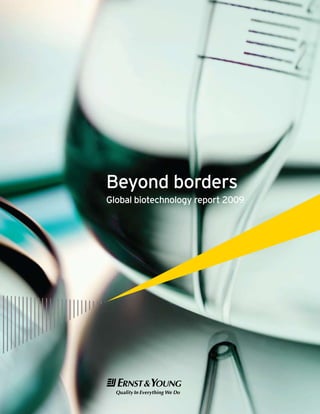



















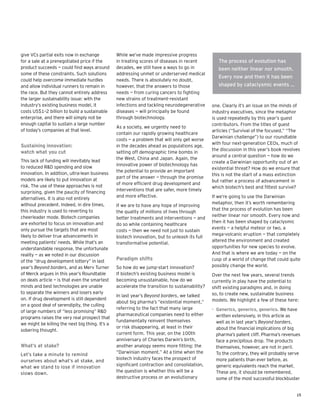









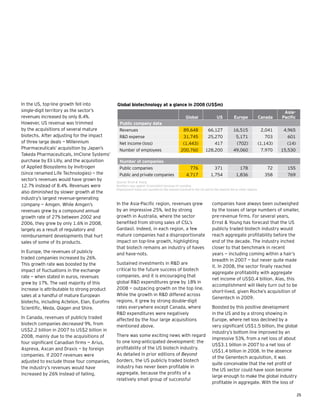













![39
other companies. Now more than ever we have to make sure
that the breakthrough drugs we will need for our growth are
developed from within.
Lange: We have spent much of the last five years ending in
late 2008 monetizing a decade-long US$1 billion investment
in R&D that resulted in three product approvals and two
partnerships. As a result, we were able to initiate new revenue
streams and pay down much of our debt. Of course, we didn’t
know that the financial markets were going to crater, but
in hindsight our timing was good. We are going forward in
2009 with a healthy amount of cash on the balance sheet and
enough money to get to profitability if things go well. We were
preparing to become a profitable biotech company regardless
of the economic picture. That strategy now provides us with
many different choices that are reasonably independent of
having to raise equity dollars. I’m incredibly optimistic about
CV Therapeutics. We had three products approved last year,
we raised money, we have a robust pipeline and a strong
regulatory track record. We have very good relationships and
credibility with both the Food and Drug Administration and the
European Medicines Agency. We have a bright future with a
lot of value that is only going to increase. [Editor’s note: in the
months after this interview, CV Therapeutics was acquired by
Gilead Sciences for US$1.4 billion.]
Ernst & Young: Challenging economic times produce new
risks as well as new opportunities. On balance, which is
greater for your company at the current time — emerging
opportunities or new risks? What specific challenges or
opportunities are you seeing?
Goddard: There’s much more opportunity than threat for
a company like ours, which is anchored around a solid and
growing product, because it allows us to look for strategically
enriching platform technologies or pipeline assets. We need
to do this in a thoughtful manner. First, we need to remember
that just because something is on sale doesn’t mean that it’s a
good buy.
Second, companies at our stage of evolution face more earnings
scrutiny, which implies that we need to appropriately balance
financial performance against reinvestment. While we’re all trying
to create value, there’s an inevitable dichotomy between the focus
of some shorter-term investors and the generally longer-term
view of companies. Investors have a job to do which can lead to a
shorter-term focus. But to create sustainable shareholder value,
we need to balance short-term financial performance against
the longer-term need to reinvest. One way to do this could be
through creative and thoughtful transactions that have less
income-statement impact. Over time, of course, with sustained
top-line growth comes credibility and more latitude from investors
to reinvest. We’re on that journey, but it does impact how we
respond to the opportunities in front of us today.
Those are the opportunities. In terms of risk, one of our
frustrations is around the volatility in interest rates and
currency exchange, since a significant proportion of our
revenues are earned outside the US. We are considering
hedging strategies, but the volatility is there at a level that is
quite unusual. It’s something for us to think about in terms of
managing the business as a whole.
Bienaimé: Interest rates have impacted us as well. Interest
rates have fallen with the onset of this recession, lowering the
interest income on our fairly sizeable cash balances and creating
more risk on this front. The most significant risk, though, is the
potential pressure on reimbursements. This hasn’t materialized
yet, but, if economic conditions around the world deteriorate,
I’m sure there will be some pushback from payors.
In terms of opportunities, as already mentioned, there are
several smaller biotech companies that have no revenues and
no cash. We are getting an increasing number of calls about
companies that are desperate, some of which have decent
assets but no ability to fund further development. That creates
buying opportunities for us.
Bigger companies may be less willing to buy some of these
struggling companies. Well, we’re not big pharma. We
are willing to take some risks with which they may be](https://image.slidesharecdn.com/e51925b5-87b1-4f14-99b1-c6a5d0296342-160709162519/85/2009-EY-Biotech-Report-45-320.jpg)


